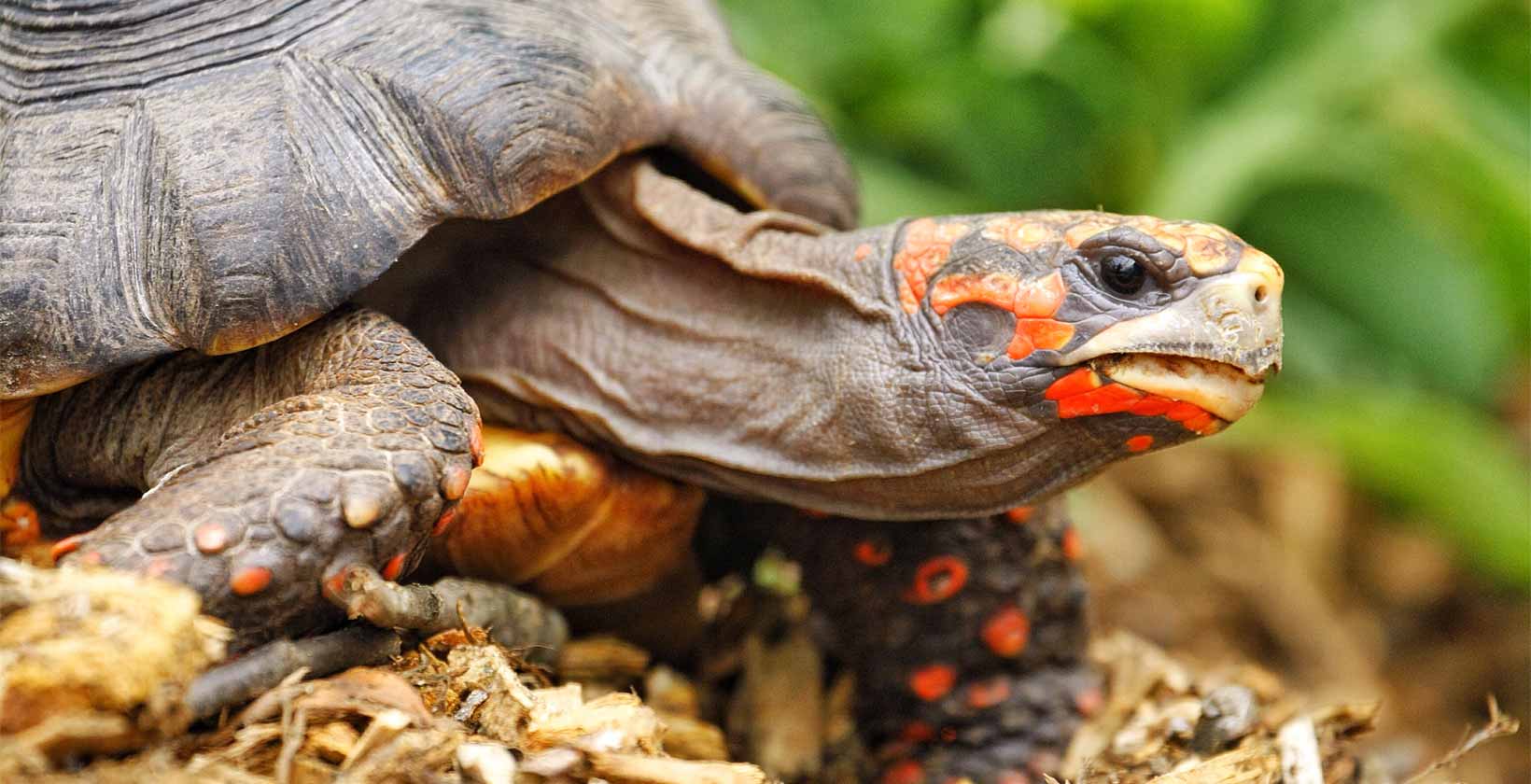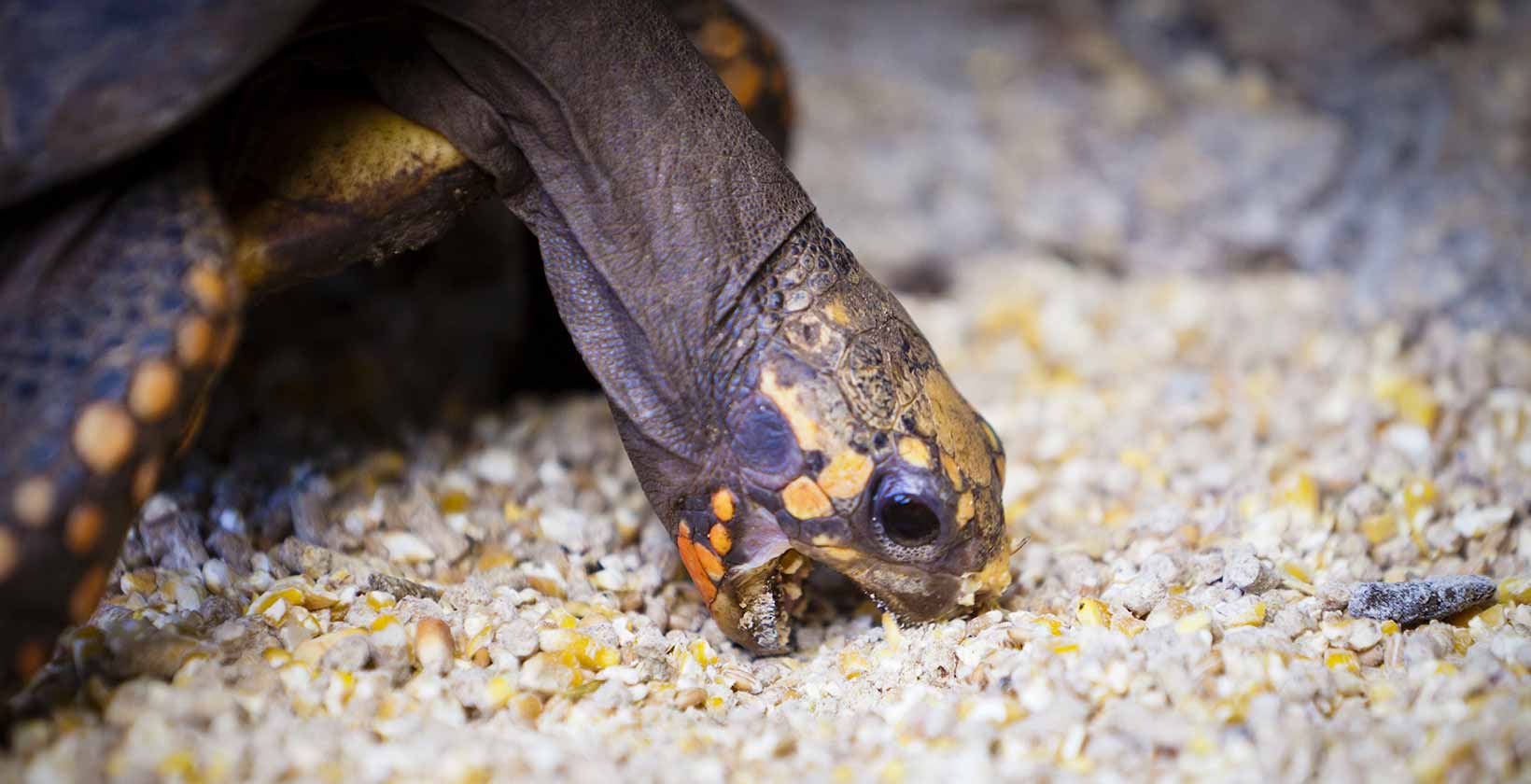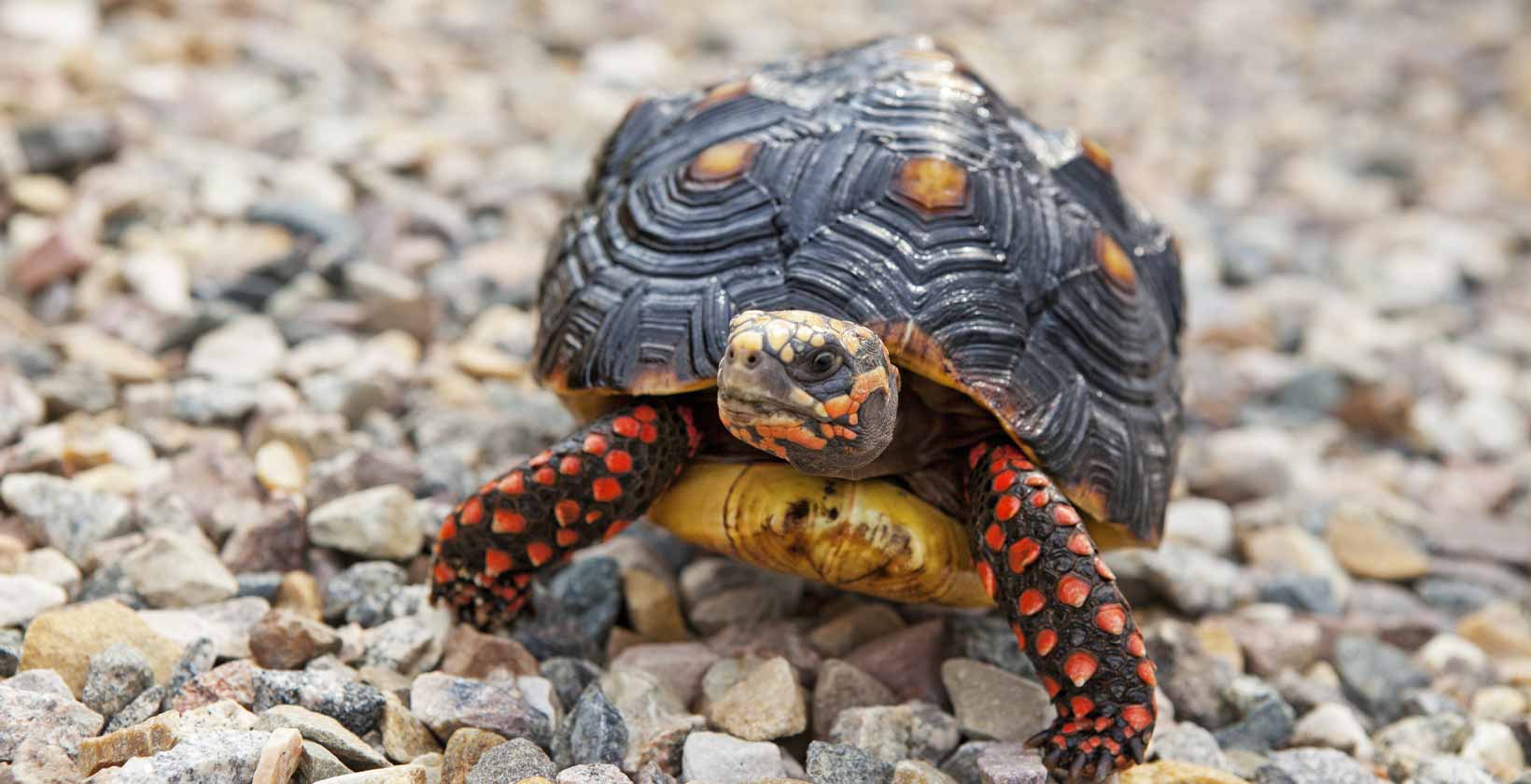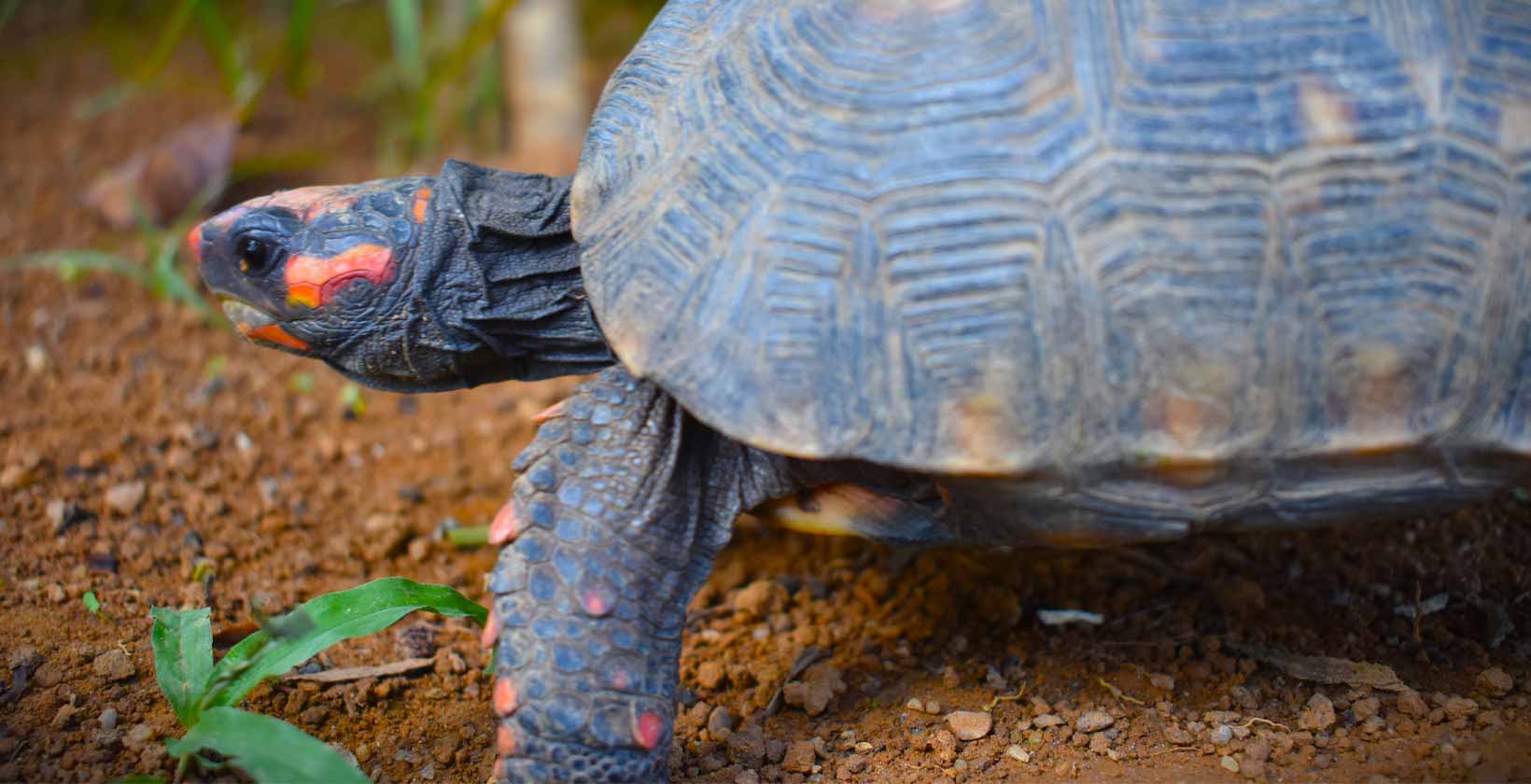Red-footed tortoises have beautiful coloration, a lovable personality, and are moderate in size. They are popular amongst turtle keepers and are not difficult to keep.

| SPECIES OVERVIEW | |
| Scientific name | Chelonoidis carbonarius |
| Common name | Red-Footed Tortoise |
| Family | Testudinidae |
| Genus | Chelonoidis |
| Species | C. carbonarius |
| Size | 10-16 inches (25-40 cm) |
| Life expectancy | 50-90 years in captivity |
| Habitat size | 50 square feet minimum |
| Humidity | 60-75% |
| Temperature | 60-95°F (15.5 – 35°C) |
| Diet | Greens, fruit, tortoise diet |
Caring for a red footed tortoise is simple. These turtles have specific housing and feeding needs to keep them healthy and happy. Here’s what it takes to provide good care to a red foot tortoise:
Quick Navigation
Red Footed Tortoise Housing Requirements
A red-footed tortoise will be most comfortable in an outside home. They can live in an outdoor enclosure if temperatures don’t fall below 60-65°F (15.5 – 18.5°C). When the climate doesn’t permit it, red foot tortoises should winter indoors.
By living outdoors, red foot tortoises get plenty of fresh air and sunshine and have dirt for digging. But an outdoor enclosure needs to keep out predators like cats, dogs, coyotes, or raccoons. To deter invaders, cover the top of the enclosure with chain-link fencing or chicken wire.
While your red-footed tortoise needs sun, you also need to provide shade. A small plastic waterproof dog house can serve as a hide and keep your tortoise out of the rain. You can also put some big rocks or logs in your redfoots’ outdoor enclosure to provide hiding places.
Red Footed Tortoise Enclosure (Cage Size)
Redfoots are naturally curious, needing space to wander about and explore. That’s why the least amount of space you need for a full-grown red foot tortoise enclosure is 8 ft. x 5 ft (40 sq ft or 3.7 sqm).
The walls of the enclosure must be at least 16-18 inches high and extend at least six inches below the surface. Because redfoots have an inquisitive nature, the walls should also be opaque. If they can see through, they will dig to explore, not hesitating to escape if they discover a potential exit. Digging under the walls or rubbing against the wire, can potentially harm their noses.
Substrate
Outdoor enclosures provide enough natural substrate for red-footed tortoises. Yet, you must ensure that they roam in areas free of weed killers or pesticides. For an inside enclosure, give them at least six inches (15 cm) of substrate for exploratory digging.

Cypress mulch is a great substrate for your red-footed tortoise’s bedding. It’s absorbent, safe, and low-priced. Place a couple of inches (5 cm) of mulch atop a mix of 50/50 Reptisoil and play sand. That way you simulate the conditions of their South American home habitats.
A clean and healthy habitat for your red-footed tortoise is a must. Start by spot cleaning the substrate whenever required. Change it out completely, every 2-3 months.
Heating
An indoor red foot tortoise enclosure should at 68-80°F (20-27°C), with a basking area of around 90°F (32°C). Use a ceramic heat lamp and a thermostat to prevent things from overheating.
When living outdoors, red-footed tortoises will tolerate broad temperature ranges. They need a shaded area to escape hot temperatures, and a heated hide box to keep them warm during a cold snap. Use misters and sprinklers to cool your tortoise and keep the humidity high.
Lighting
Red-footed tortoises need sun or UV light exposure to be able to synthesize vitamin D3 in their skin. Without proper levels of vitamin D3 your tortoise’s ability to absorb calcium is affected. That could lead to a condition called metabolic bone disease (MBD). MBD causes softened bones, permanent shell deformities, seizures, and can lead to death.
A pair of T5 HO fluorescent grow bulbs or similar powerful LEDs are enough for an indoor enclosure. To ensure sufficient vitamin D production and calcium absorption, leave them on for 10-14 hours a day.
Humidity
In the wild, red-footed tortoises retreat into burrows when the air gets too dry and warm. To prevent too dry and too warm air, provide a dig box filled with at least six inches of moist sphagnum moss.
Indoor enclosures should have a humidity reading between 50% and 70%. You will be able to measure humidity with any inexpensive hygrometer (humidity gauge). Just make sure you keep an eye on it.
Also, note that these tortoises should have a pan of clean water available at all times. Keep an eye on the water dish and change it as required, since they frequently poop in the water.
Feeding a Red Footed Tortoise
Red-footed tortoise’s diet should be fruits (70%). greens and broad-leaf gaze, but won’t say no to slugs, snails, and worms. As pets, the bulk of a red-footed tortoise’s diet should be fruits (70%), dark leafy greens (25%), and animal protein (5%).

Below are a few healthy examples of foods red footed tortoises should eat:
- Red-footed tortoises love tropical fruits like papaya, mango, and bananas. They will also enjoy watermelon and strawberries (a favorite).
- For vegetables feed them leafy greens like romaine lettuce, kale, or collard greens. Spice up their diet with zucchini, pumpkin, or squash.
- For animal protein intake consider an occasional treat of chopped hard-boiled eggs or mealworms. Keeping a natural cuttlebone in their enclosure will help your redfoot keep its beak smooth. It will also provide them with supplemental calcium as needed.
Common Red Footed Tortoise Health Issues
Keeping a healthy diet and a proper enclosure for your red-footed tortoise prevents it from getting sick. Redfoots are prone to several medical conditions, so be aware of behavior changes and report them to your veterinary as soon as possible.
These are the most common health problems for red-footed tortoises:
- Overgrown nails can occur if your red foot doesn’t have access to a substrate that allows for digging. You can keep your tortoise’s nails trimmed with dog nail clippers to avoid problems.
- Exposure to low temperatures, stress, or dirty enclosure conditions can lead to respiratory infections. If your red-footed tortoise is wheezing or if you notice crusty deposits around its nostrils, see your veterinarian.
- Unhygienic habitat conditions can lead to bacterial infections that cause shell rot. If you notice pitting, dimpling, discoloration, or cracks in your redfoot’s shell, you could be dealing with shell rot. Contact your veterinarian immediately, clean your tortoise’s enclosure thoroughly, and keep it more sanitary going forward.
- Intestinal parasites like roundworms can cause vomiting, lethargy, and lack of appetite in red foot tortoises. Intestinal parasites are especially common among imported red foot tortoises. Since the US only allows imports of redfoots that are over 4 inches (10 cm) long, you can be sure that red-footed tortoises under that size are captive bred.
Where to Buy a Red Footed Tortoise

Red-footed tortoises can be available in pet stores, but buying from a reputable tortoise breeder is the better solution. Pet store animals are often kept in poor conditions and come with health problems. That leads to costly vet visits or heartache for the pet owner. Reptile expos are also a great place to find healthy red-footed tortoises for sal. You also get tips on caring for them from experienced keepers.
Red Footed Tortoise Variations

No subspecies of red-footed tortoises are currently recognized, but localities are. Characteristics like color and size are specific to different regions in South America. These variations include:
- Cherryhead redfoot tortoises (Geochelone carbonaria) originate in southern Brazil. Cherryheads are slightly smaller than more northern redfoot tortoises. They have varying degrees of red on their heads that can range from red specks to brilliant solid reds.
- Hypomelanistic (“Hypo”) redfoot tortoises lack melanin, the gene that creates pigment in your body. Similar to an albino. they have recently become available in the pet trade but are quite expensive. ($4k and up).
- Yellow foot tortoises (Chelonoidis denticulatus) are also known as the Brazilian giant tortoise. They look quite like the red-footed tortoise hatchlings in yellow when they are young. But they are actually a different species. They get considerably larger and are more fragile than red-footed tortoises.
Frequently Asked Questions
What is the red footed tortoise’s scientific name?
The red-footed tortoise’s scientific name is Chelonoidis carbonarius. Chelonoidis, the Genus name, describes a family of South American and Caribbean tortoises including the Redfoot and Galapagos tortoises. The species name carbonarius is Latin for “charcoal burner.”
How big do red-footed tortoises get?
Red-footed tortoises are medium-sized tortoises. Females average 11 inches (28.5cm) long and weigh up to 20 pounds (9 kg). Yet, males are slightly larger at up to 13.5 inches (34 cm) long and up to 30 pounds (9 kg) in weight, though some get larger.
Where are red-footed tortoises from?
Red-footed tortoises are found throughout South America from Panama to Argentina and on the islands of Trinidad and Barbados. The red-footed tortoise is not fussy about its habitat. It can be found in places like forests, grasslands, and savanna regions.
How often do you feed a red-footed tortoise?
The red-footed tortoise is not fussy about its habitat. It can be found in places like forests, grasslands, and savanna regions.
What do red-footed tortoises eat?
In the wild red-footed tortoises eat leaves and fruits. But they also supplement their diet with insects, bird eggs, and even carrion. Pet redfoot tortoises should be given a regular diet of fruits and greens with weekly supplemental animal protein.
How long do red-footed tortoises live?
Red-footed tortoises live 50 years or longer. Once they get past their small and vulnerable period, red-footed tortoises have few natural enemies. Chuck, a red-foot tortoise residing at the Berkshire Museum in Massachusetts, is over 70 years old and still going strong.
Do red-footed tortoises hibernate?
Red-footed tortoises do not hibernate. They come from equatorial regions where the climate is relatively constant throughout the year. If your redfoot tortoise seems sluggish in the winter, check the environment temperature. It may be getting too cold at night.
Are red-footed tortoises good with children?
While redfoot tortoises are generally docile, they can get defensive if handled roughly. Since their beaks are strong and sharp, make sure your children aren’t adding any unnecessary stress. Also, note that reptiles can spread salmonella. It’s advisable to wash hands after touching tortoises or cleaning a tortoise enclosure.
What is a cherryhead redfoot tortoise?
Cherry-head tortoises are smaller red-headed variants of Chelonoidis carbonarius, the common red-foot tortoise. They can be found in the rainforests of northern and eastern Brazil. Care requirements are almost identical to redfoots, though they prefer their humidity on the higher end.
How much are red footed tortoises?
A juvenile red-footed tortoise from a reputable breeder will cost between $250 and $400. Cheaper red-footed tortoises could be available for sale, but a sick or poorly maintained tortoise may cost you a lot more in vet bills.
Conclusion
Red-footed tortoises don’t ask for much from their keepers, but they are a lifetime commitment. That hatchling redfoot you pick up at a reptile expo may be passed on to your children and grandchildren.
If you have the space and you’re ready for a life filled with red footed tortoise companionship, we’re here to answer all your questions.